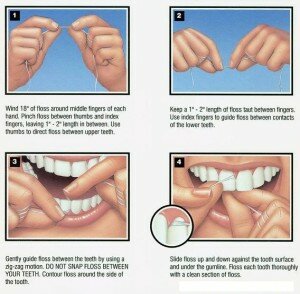 You have been told throughout your life, from your parents and family dentist, that brushing and flossing are essential to keeping your teeth healthy and beautiful. However, many people still don’t take the time each day for these simple, yet crucial, practices. This is largely why so many suffer from gum disease and tooth decay, often without even knowing it.
You have been told throughout your life, from your parents and family dentist, that brushing and flossing are essential to keeping your teeth healthy and beautiful. However, many people still don’t take the time each day for these simple, yet crucial, practices. This is largely why so many suffer from gum disease and tooth decay, often without even knowing it.
The diet of the average American is very rich in starches and sugars. These foods trigger the release of acids in the mouth, which in turn attacks the teeth causing decay. Another culprit, a bacterial buildup called plaque, can wreak havoc on both the teeth and gums and is the primary cause of gum disease which affects many Americans and can eventually cause tooth loss if left untreated.
To reduce both the acid and plaque in the mouth, limit the amount of starchy and sugary foods in your diet and make sure to brush after all meals and floss at least once per day. Choose a soft-bristle brush that is able to reach all the areas of your mouth including the rear molars. These molars are usually the most prone to cavities as their ridges and difficult location often make them a collection area for food particles and bacteria. When you go to choose a toothpaste, remember that all individuals old enough to know not to swallow toothpaste should use fluoride toothpaste when brushing. Fluoride both strengthens the teeth as well as provides them with a protective layer that helps to prevent decay.
In order to properly brush your teeth, place your toothbrush at an angle of 45 degrees against the teeth and gums and use short circular strokes to gently clean all surface areas of each tooth. Also, remember to brush the tongue as well. Doing so can help to eliminate bad breath as well as eliminate bacteria.
While brushing is crucial, the toothbrush can’t reach everywhere and this is where flossing comes in. Floss can reach all of those small areas that the brush cannot, specifically between the teeth and down by the gumline. In this way, flossing goes a long way toward preventing gum disease.
To properly floss, break off a piece of floss that is approximately 18 inches in length. Use one of your middle fingers as a spool around which the clean floss is wound and the opposite middle finger as a means of collecting the floss once it is used. When flossing, always make sure that you use a clean piece of floss for each tooth. Gently slide the floss between your teeth and down to the gum and use a C shape of the floss to clean the surface of the tooth. While you want to get the floss between the tooth and the gum, you do not want to do so in a way that causes your gums to bleed. If your gums bleed even when you are being gentle, it may be a sign of gingivitis. Make an appointment with us and we will examine your gums and give you suggestions on how to improve your brushing and flossing habits.
If you ever have any questions about proper flossing and brushing habits, give us a call or ask us during your next appointment. After all, we have your dental health at heart.







